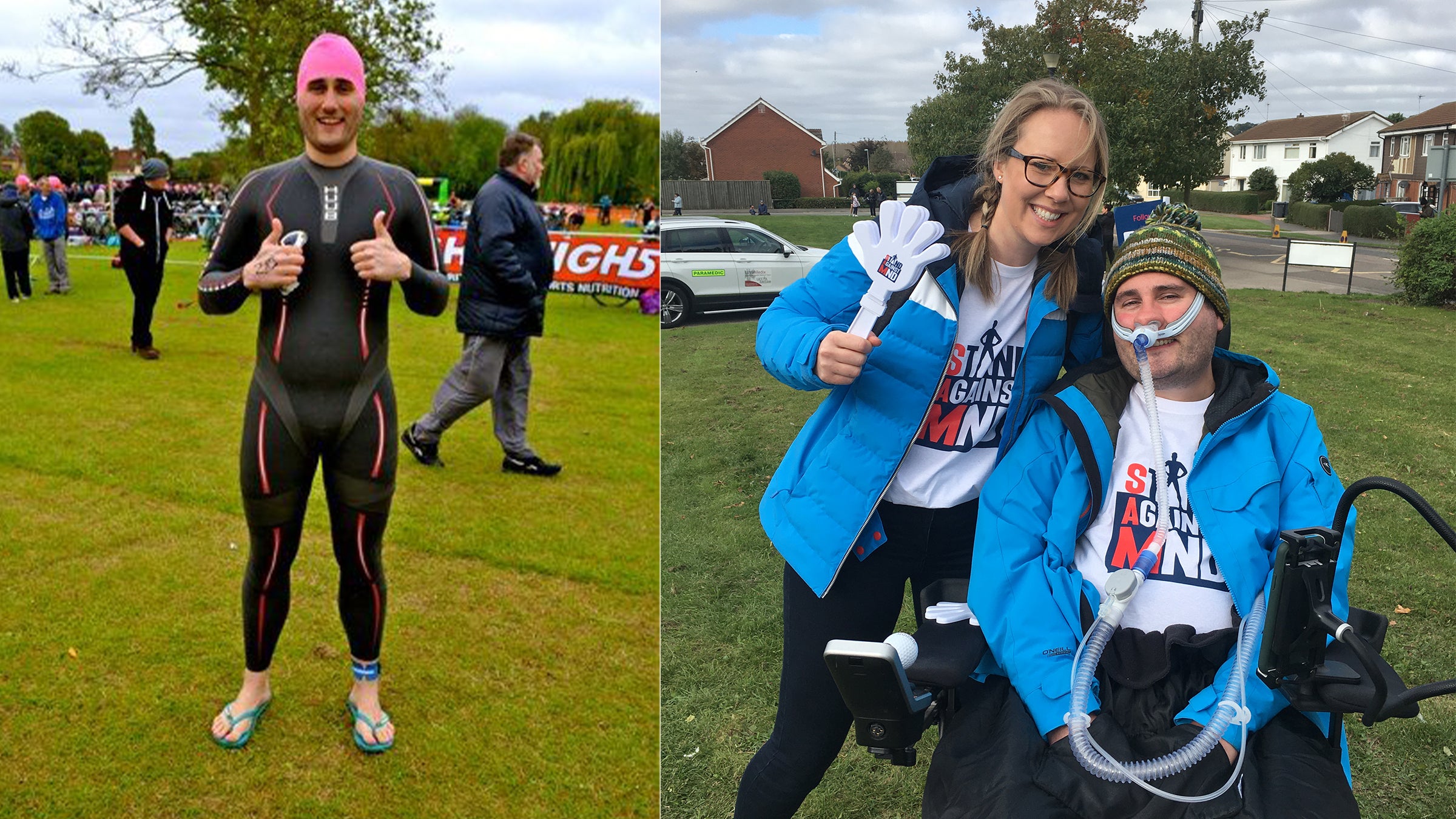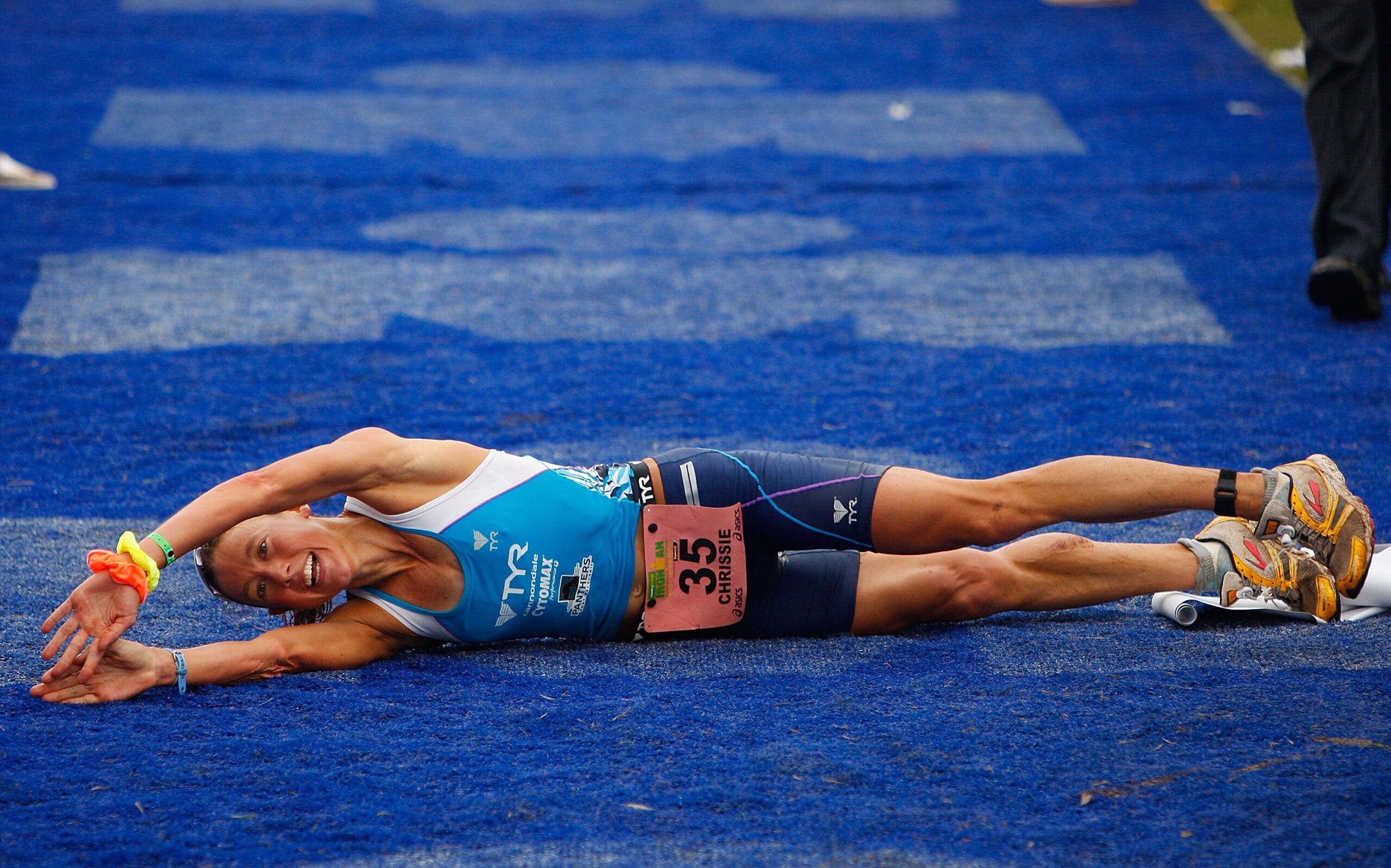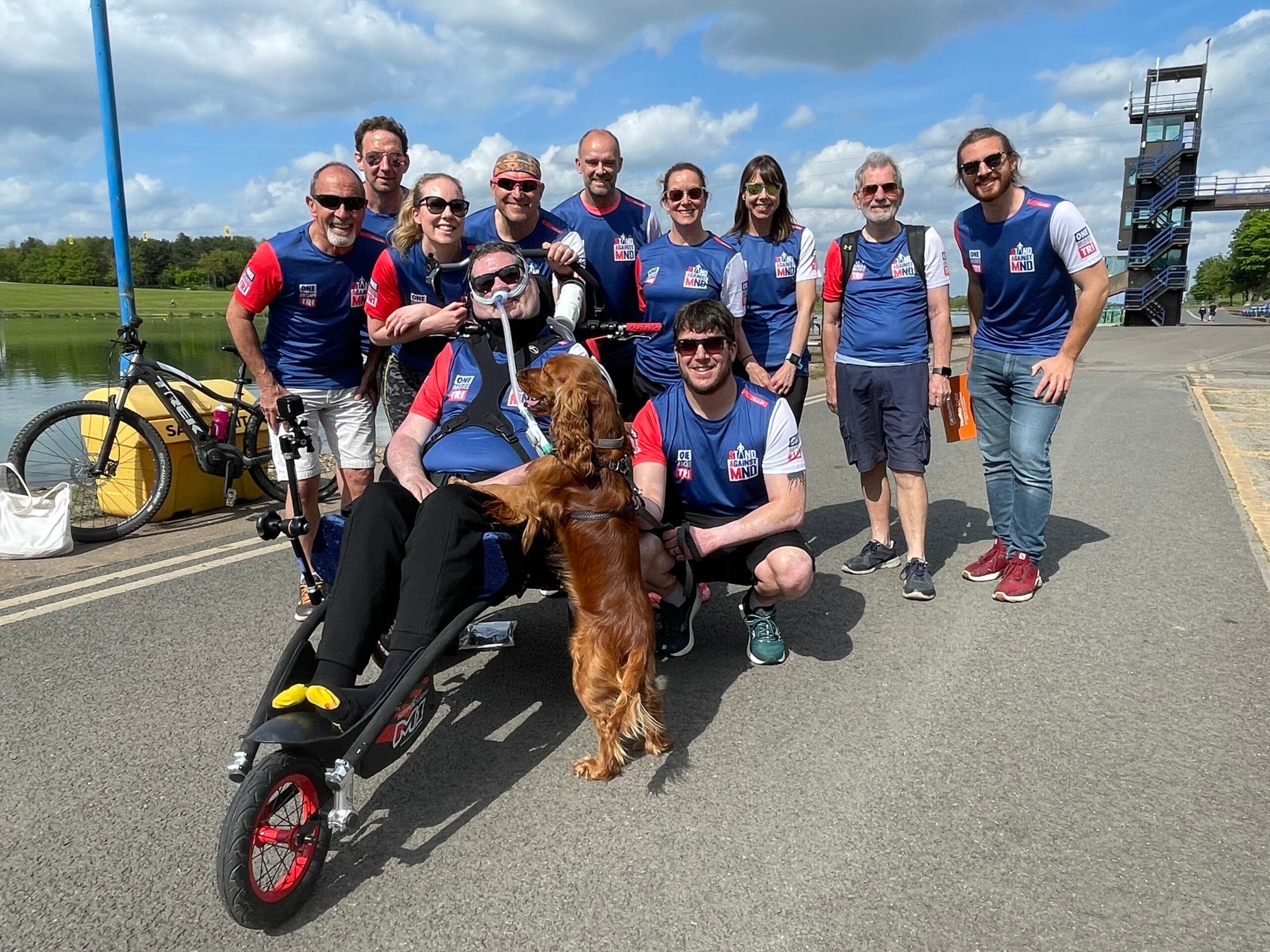After an ALS Diagnosis, Sam Perkins Wants One More Tri

When Sam Perkins was training for his first Ironman he had the sound of a four-time world champion ringing in his ears. The just-retired Chrissie Wellington had recorded an audio series to complement training intervals; motivational words to go with an upbeat tempo for bike and run sessions.
There’s one line that particularly stuck with Perkins: “Your limits may not be where you think they are.”
In 2014, Perkins thought his limit might be completing Ironman UK in Bolton. Two years later he was back at the full distance at the Outlaw Triathlon in Nottingham trying to go faster. But at the start of 2019, those limits—and just about everything else—changed.
The 40-year-old from Leicestershire in the U.K. was diagnosed with motor neurone disease, better known in the U.S. as ALS or Lou Gehrig’s disease. Not only that, Perkins’ was a rare form of respiratory onset ALS, and it was progressing rapidly.
It was the collapse of his diaphragm, leading to contracting pneumonia, that had sealed the diagnosis. As he lay in his hospital bed, contemplating the news, what he perceived he could achieve was shrinking by the day.
What he wanted was one final triathlon.
One More Tri
When I met Perkins in late summer of 2019, he was already in a wheelchair with a ventilator facilitating his breathing. He could still hold a conversation, but was “voice banking” in case he would have to communicate through a keyboard in the near future.
At the time, Perkins was with his father at tri brand Huub in the U.K., a connection he’d made years earlier when through his role as a business consultant he’d helped founder Dean Jackson apply for the funding to grow the business.
Jackson was keen to return the help now, but as Perkins says, this is the “cruelest of diseases.” You are handed a diagnosis, and pretty much sent home with a shrug. There’s little anyone can do other than make you comfortable as the condition takes hold.
One of the reasons he believes more money isn’t plowed into research is that people don’t survive for long, so at any given time there aren’t as many living with the condition as other terminal illnesses. Life expectancy can be three years or shorter. It’s viewed as rare, but in fact around 1 in 300 will contract it during their lifetime. There is no cure.
Despite this Perkins has a sparkle, a sense of humor, and resilience that’s extraordinary. It’s allied to a gift for bringing others together for the common good, and a determination to cross that triathlon finish line one more time.
All these are reasons why Wellington, on hearing of his story and ambition to complete one final event, wanted to meet him. But there’s another connection too.
Wellington retired in 2011 after four trailblazing years at the top of Ironman racing where she was unbeaten over the distance. The last race was in Hawaii, a famous, battle-scarred win having overcome the effects of a nasty bike crash that happened a fortnight earlier. It was one that Perkins, and many other tri fans, remember well.
Followers of the sport became used to Wellington not only taking the tape at every race, but returning to roll over the finish line, arms extended. The log roll or Blazeman roll was in respect to Jon Blais.
“I started my pro triathlon journey in 2007 and was fortunate to race and win Kona in that same year,” Chrissie said. “I was also fortunate to meet Mary-Anne and Bob Blais at the finish line. They shared Jon’s story and their efforts to try to raise awareness about ALS.”
Their son was Jon, a 33-year-old triathlete, originally from Massachusetts, who was diagnosed with ALS in March 2005. Determined not to give in to the disease, he completed Ironman Hawaii in the fall of the same year. When you understand how ALS manifests it’s an achievement that is little short of miraculous.
He passed away a little over four months before Wellington won the first of her four Kona titles.
“On hearing why athletes were doing the log roll, I vowed to do one in every race from thereon in,” she said. “It was in support of raising awareness through the Blazeman Foundation, a symbolic gesture, and mark of respect to Mary-Anne and Bob, who became good friends.”
Where the Blais family created the Blazeman Foundation in memory of Jon, Perkins’ final triathlon, aptly named One More Tri, will raise money for Stand Against MNB (or SAM for short), a charity founded by Perkins and his wife Emma to fund research for the disease.
“Jon’s story spoke to me in a similar way your story speaks to me, Sam,” Wellington said. “What Jon managed to achieve with the challenges he faced, with his determination, resilience, tenacity, and willingness to put a finger up to doctors who said: ‘You can’t!’ is inspirational.
“His response of ‘I’m finishing, even if you have to roll me across the line,’ is where the log roll originally came from. Every year I raced, the day before the race, my crew would form a big circle and read a Hawaiian poem. Mary-Anne and Bob were part of that, so it felt personal. I carried on log rolling across the finish line even after I retired.”

This Sunday, in the Outlaw Half in Nottingham, Perkins will be pushed across the line in his chair.
With the challenge originally set for the summer of 2020, the delays caused by the COVID-19 pandemic have given time—already so short—for his condition to advance.
For safety, he’s no longer able to be towed in a dinghy in the swim, nor pushed on the 56-mile bike course, but his training partner of old, Steph Cobb, and stepdad Nick Rawling, who first got him into the sport, will step in for the first two disciplines.
Perkins’ celebratory lap of honor will be five circuits of the rowing lake, a little over the scheduled 13.1-mile distance, to complete the event.
He has assembled a team for each lap to take on pushing duties, including one lap made up of former players from his beloved soccer club Nottingham Forest, with his two sisters and wife taking charge for the final loop.
For those present, it will be an emotional day. Not least because Perkins’ story is one that will resonate with so many readers for whom triathlon has become an unlikely passion.
Like many of us, he fell into the sport almost by accident. “I’m not your lifelong athlete who got into tri because I was constantly active,” he said. “In my 20s I was more interested in going to the pub than for a run. I wasn’t particularly fit and about 18 stone [250 pounds].
“On Christmas Eve in 2009 I was talking to my stepdad in the pub and we started talking about triathlon—I think you might have been mentioned, Chrissie! I said I wanted to do something to get fit but three sports, one after the other sounded bonkers!
“Still, half-inebriated I agreed I’d go to a local tri club in the new year and give it a go. I was expecting it to be quite competitive and suffer quite a lot of judgment as a non-exercising big guy. But we know triathlon. I was welcomed with open arms!
“I’d always seen exercise and sport as competitive, but it was such a personal challenge, that was competition enough. I’d be so proud of myself; I didn’t care if I came in last… I was third to last.” By the end of 2010, Sam had completed eight sprint triathlons and lost about 5-and-half stone [75 pounds].
“It’s analogous to my journey in that we came to it relatively late,” Wellington said.
After an early career in overseas development, Wellington also didn’t start in the sport until the age of 26. “Someone suggests it, you think it’s inconceivable, but are kind of intrigued. The challenge appeals. When I started, I never had any expectations of being good. It was just something to try.”

A New Limit
The early signs of ALS made Sam feel like a hypochondriac. A sore shoulder that didn’t fully recover after a fall when skiing, prolonged muscle vacillations after exercise, then he started to notice he’d become short of breath when he lay on his back.
“I went to the doctor with this long list of symptoms and the first thing he said was: ‘You’re probably thinking MND, but it’s not, you’re not old enough.’”
But sleeping became more difficult. Every time Perkins tried he’d struggle for oxygen and his body would wake him. It culminated in pneumonia and being rushed into hospital unable to cough up the fluid from his lungs.
“There’s no one test that says you’ve got MND. They knew things weren’t quite working right, but it was critical care where I was finally diagnosed.”
If the news was bleak, the way he responded so positively with a what-can-we-do approach is perhaps the most inspiring aspect.
“I’d credit the lady to my left with a lot of that,” he said, turning to his wife, Emma. “I remember sitting by my hospital bed a couple of days after the diagnosis and feeling pretty crappy about life.
“We’d already talked about the need to move house and all I was seeing were problems. She just said: ‘If things need to change, we’ll just do it. Whatever you need, we’ll make happen.’
“I had a moment where I just thought, this thing doesn’t need to stop me. Tap back into that triathlon mentality, where you realize the biggest limiter is inside your head.”
Turning back to Wellington, he adds: “I remember the little mantras you wrote on your bike and water bottle, and the lines from your Audiofuel series, such as ‘Your limits may not be where you think you are.’ I then saw MND as a new challenge and I didn’t know where my limits might be, so let’s push as hard as I can.
“It just switched that day. I thought, whatever I want to do, I’m going to try to do it. And if I can’t, then at least I’ve tried—although when COVID came, I did briefly think somebody, somewhere had it in for me. I’d been chucked one of the worst things in life, and now a once-in-a-lifetime pandemic as well!
“But the parameters changed, we hit the reset, and we tapped into support networks. That’s another triathlon thing. I could never have trained for an Ironman without Emma supporting me.”
A special racing wheelchair has been adapted for Perkin’s final triathlon, allowing him to be as comfortable as possible for the three hours or so the run leg will take. If the event achieves anything, he’d like it to be more awareness, so more funds are committed to research.
“We had friends saying: ‘What is that? What does it mean?’” Perkins explains. “I don’t think I even fully comprehended the enormity of the diagnosis and how few options there were. Well, no options really. The disease will do what it’s going to do, and we just have to cope.
“I spent my professional career raising funding for research and development, and when I heard the figure being put into research for MND, it was pitiful. It’s thought of as being this rare disease, but to put it really bluntly, it’s only because people die so quickly.
“We started our own charity because we wanted the money donated in my name to go to research. If it was my money, that’s where I’d put it. We were lucky enough to visit a lab in Nottingham last week and they are doing research with funds that we’ve raised. Our funds paid for a PhD student, who we met and talked to about their research in finding a cure.”
Perkins’ One More Tri is set to be a celebration, not just of his own experience but of others. “To be on the course, encourage others as they run past, to see my old tri club running the aid station at the top of the lake, and just to be in that environment, I am almost certain I will cry.
“It’s the chance to do something that I thought had been unexpectedly taken away from me again, one of the things that gave me the most self-worth, and that I always look back on as being one of my biggest achievements.”
Sam Perkins will take part in ‘One More Tri’ on Sunday on the Outlaw Half in the U.K. To show your support and raise funds for research into ALS, visit www.justgiving.com/onemoretri